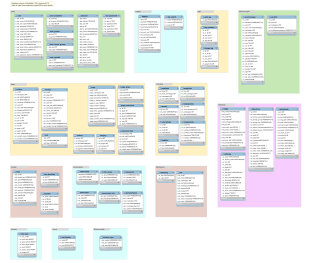Related Research Articles

In computing, a database is an organized collection of data or a type of data store based on the use of a database management system (DBMS), the software that interacts with end users, applications, and the database itself to capture and analyze the data. The DBMS additionally encompasses the core facilities provided to administer the database. The sum total of the database, the DBMS and the associated applications can be referred to as a database system. Often the term "database" is also used loosely to refer to any of the DBMS, the database system or an application associated with the database.
Denormalization is a strategy used on a previously-normalized database to increase performance. In computing, denormalization is the process of trying to improve the read performance of a database, at the expense of losing some write performance, by adding redundant copies of data or by grouping data. It is often motivated by performance or scalability in relational database software needing to carry out very large numbers of read operations. Denormalization differs from the unnormalized form in that denormalization benefits can only be fully realized on a data model that is otherwise normalized.
Database normalization is the process of structuring a relational database accordance with a series of so-called normal forms in order to reduce data redundancy and improve data integrity. It was first proposed by British computer scientist Edgar F. Codd as part of his relational model.
A relational database (RDB) is a database based on the relational model of data, as proposed by E. F. Codd in 1970. A database management system used to maintain relational databases is a relational database management system (RDBMS). Many relational database systems are equipped with the option of using SQL for querying and updating the database.
The relational model (RM) is an approach to managing data using a structure and language consistent with first-order predicate logic, first described in 1969 by English computer scientist Edgar F. Codd, where all data is represented in terms of tuples, grouped into relations. A database organized in terms of the relational model is a relational database.
Structured Query Language (SQL) is a domain-specific language used to manage data, especially in a relational database management system (RDBMS). It is particularly useful in handling structured data, i.e., data incorporating relations among entities and variables.

Db2 is a family of data management products, including database servers, developed by IBM. It initially supported the relational model, but was extended to support object–relational features and non-relational structures like JSON and XML. The brand name was originally styled as DB2 until 2017, when it changed to its present form.
In database theory, relational algebra is a theory that uses algebraic structures for modeling data and defining queries on it with well founded semantics. The theory was introduced by Edgar F. Codd.
First normal form (1NF) is a property of a relation in a relational database. A relation is in first normal form if and only if no attribute domain has relations as elements. Or more informally, that no table column can have tables as values. Database normalization is the process of representing a database in terms of relations in standard normal forms, where first normal is a minimal requirement. SQL-92 does not support creating or using table-valued columns, which means that using only the "traditional relational database features" most relational databases will be in first normal form by necessity. Database systems which do not require first normal form are often called NoSQL systems. Newer SQL standards like SQL:1999 have started to allow so called non-atomic types, which include composite types. Even newer versions like SQL:2016 allow JSON.
Second normal form (2NF), in database normalization, is a normal form. A relation is in the second normal form if it fulfills the following two requirements:
- It is in first normal form.
- It does not have any non-prime attribute that is functionally dependent on any proper subset of any candidate key of the relation. A non-prime attribute of a relation is an attribute that is not a part of any candidate key of the relation.
Third normal form (3NF) is a database schema design approach for relational databases which uses normalizing principles to reduce the duplication of data, avoid data anomalies, ensure referential integrity, and simplify data management. It was defined in 1971 by Edgar F. Codd, an English computer scientist who invented the relational model for database management.
A hierarchical database model is a data model in which the data are organized into a tree-like structure. The data are stored as records which are connected to one another through links. A record is a collection of fields, with each field containing only one value. The type of a record defines which fields the record contains.
In a database, a table is a collection of related data organized in table format; consisting of columns and rows.

In SQL, null or NULL is a special marker used to indicate that a data value does not exist in the database. Introduced by the creator of the relational database model, E. F. Codd, SQL null serves to fulfill the requirement that all true relational database management systems (RDBMS) support a representation of "missing information and inapplicable information". Codd also introduced the use of the lowercase Greek omega (ω) symbol to represent null in database theory. In SQL, NULL is a reserved word used to identify this marker.
Boyce–Codd normal form is a normal form used in database normalization. It is a slightly stricter version of the third normal form (3NF). By using BCNF, a database will remove all redundancies based on functional dependencies.
An entity–attribute–value model (EAV) is a data model optimized for the space-efficient storage of sparse—or ad-hoc—property or data values, intended for situations where runtime usage patterns are arbitrary, subject to user variation, or otherwise unforeseeable using a fixed design. The use-case targets applications which offer a large or rich system of defined property types, which are in turn appropriate to a wide set of entities, but where typically only a small, specific selection of these are instantiated for a given entity. Therefore, this type of data model relates to the mathematical notion of a sparse matrix. EAV is also known as object–attribute–value model, vertical database model, and open schema.

Raymond Francis Boyce (1946–1974) was an American computer scientist known for his research in relational databases. He is best known for his work co-developing the SQL database language and the Boyce-Codd normal form.

A database model is a type of data model that determines the logical structure of a database. It fundamentally determines in which manner data can be stored, organized and manipulated. The most popular example of a database model is the relational model, which uses a table-based format.
The nested set model is a technique for representing nested set collections in relational databases.

In database theory, a relation, as originally defined by E. F. Codd, is a set of tuples (d1,d2,...,dn), where each element dj is a member of Dj, a data domain. Codd's original definition notwithstanding, and contrary to the usual definition in mathematics, there is no ordering to the elements of the tuples of a relation. Instead, each element is termed an attribute value. An attribute is a name paired with a domain. An attribute value is an attribute name paired with an element of that attribute's domain, and a tuple is a set of attribute values in which no two distinct elements have the same name. Thus, in some accounts, a tuple is described as a function, mapping names to values.
References
- 1 2 3 Kitagawa, Hiroyuki; Kunii, Tosiyasu L. (1990-02-06). The Unnormalized Relational Data Model. Springer. pp. 1, 5, 7, 10. ISBN 978-4-431-70049-4.
- ↑ "IBM Archives: Edgar F. Codd". April 23, 2003. Archived from the original on May 31, 2006.
- ↑ Codd, E. F. (1970). A Relational Model of Data for. Large Shared Data Banks. IBM Research Laboratory, San Jose, California.
- ↑ Operations and the Properties on Non-First-Normal-Form Relational Databases H. Arisawa, K. Moriya, T. Miura Published in VLDB 1983
- ↑ Moniruzzaman, A. B. M.; Hossain, Syed Akhter (2013). "NoSQL Database: New Era of Databases for Big data Analytics - Classification, Characteristics and Comparison". International Journal of Database Theory and Application. 6. arXiv: 1307.0191 .